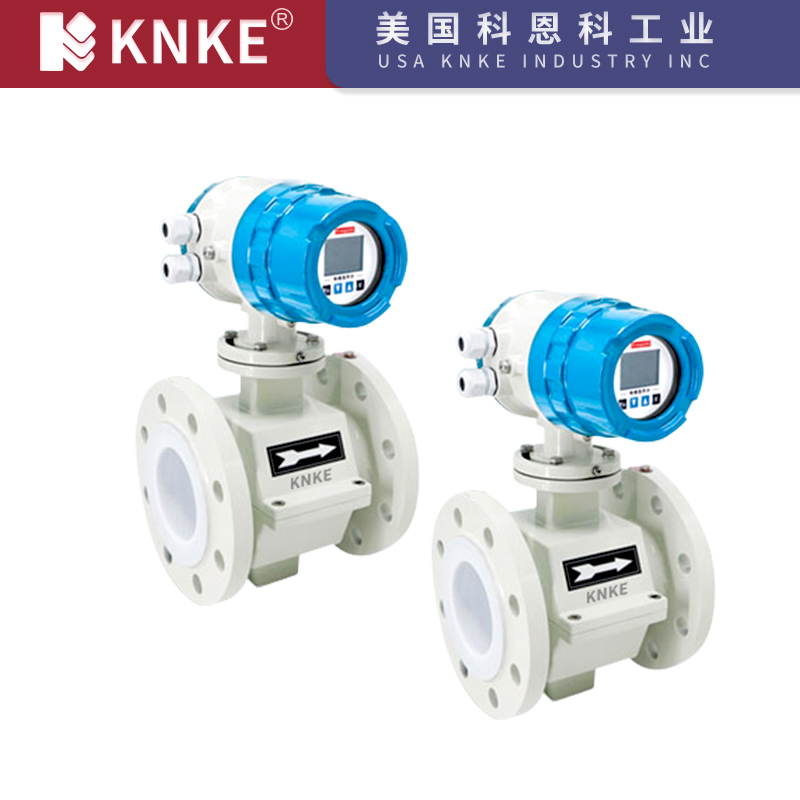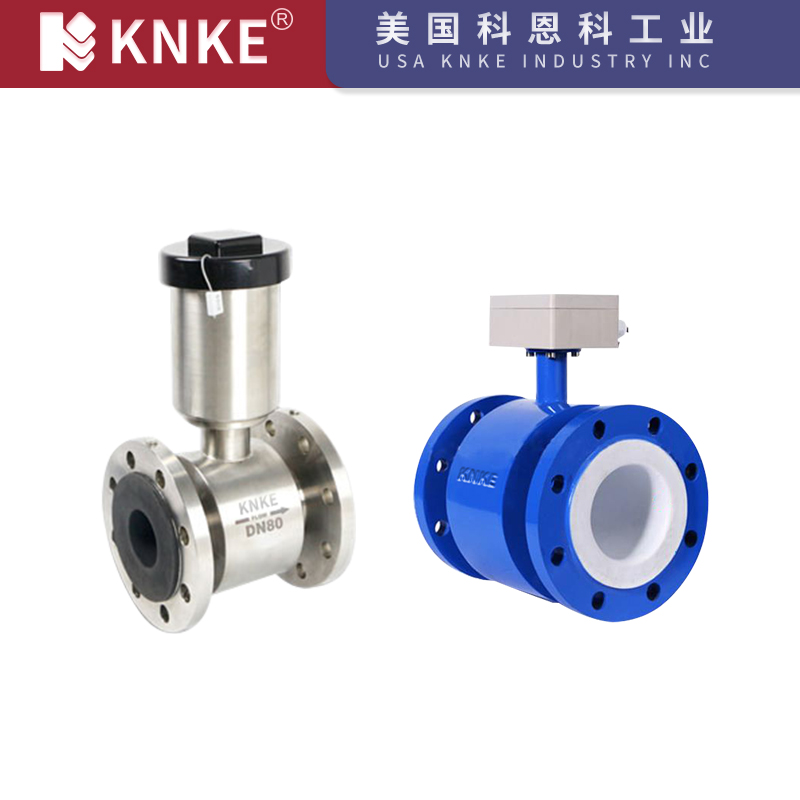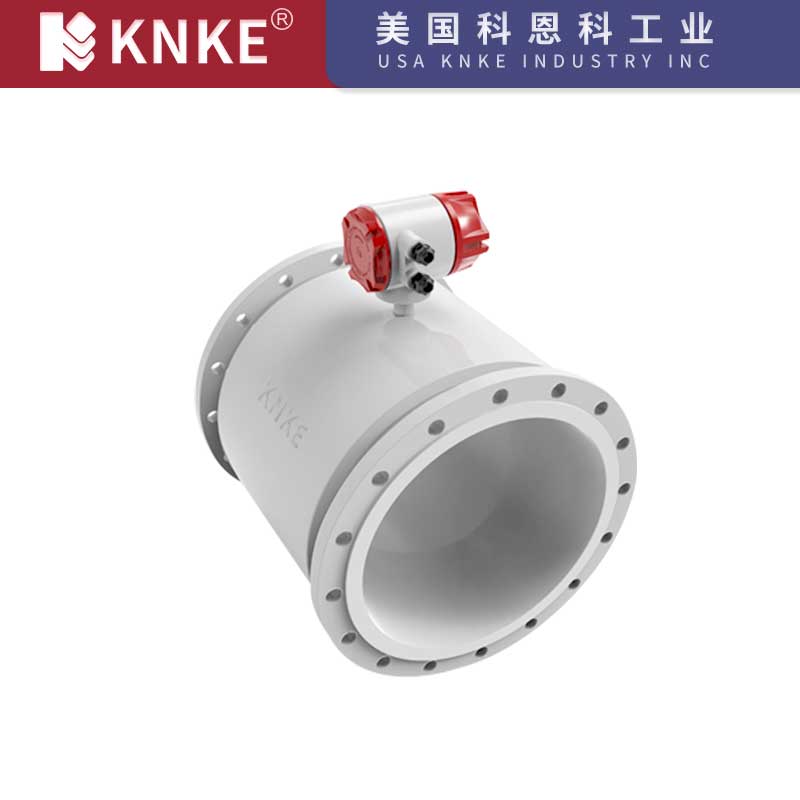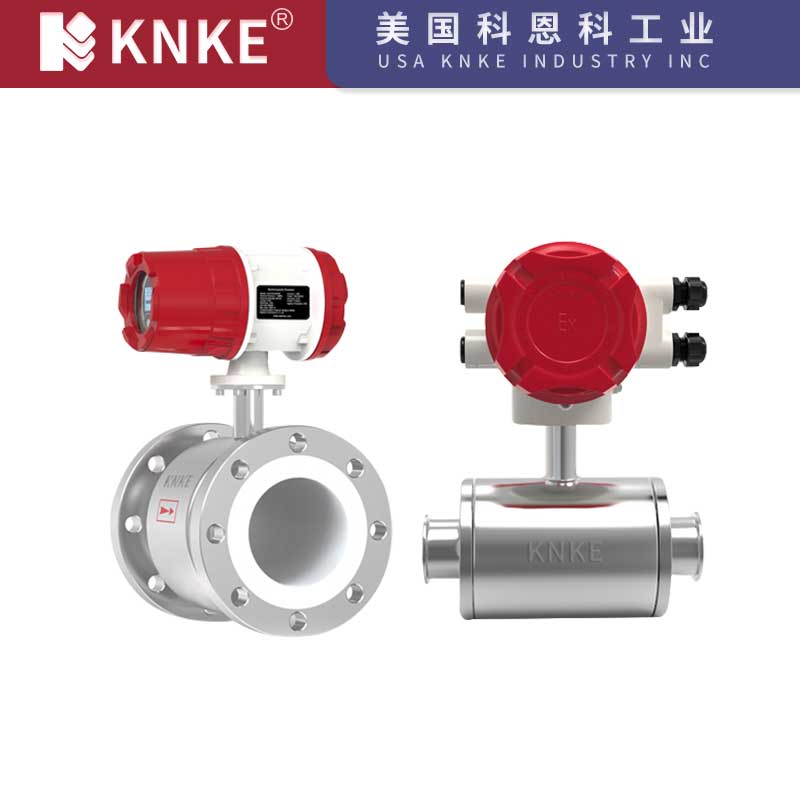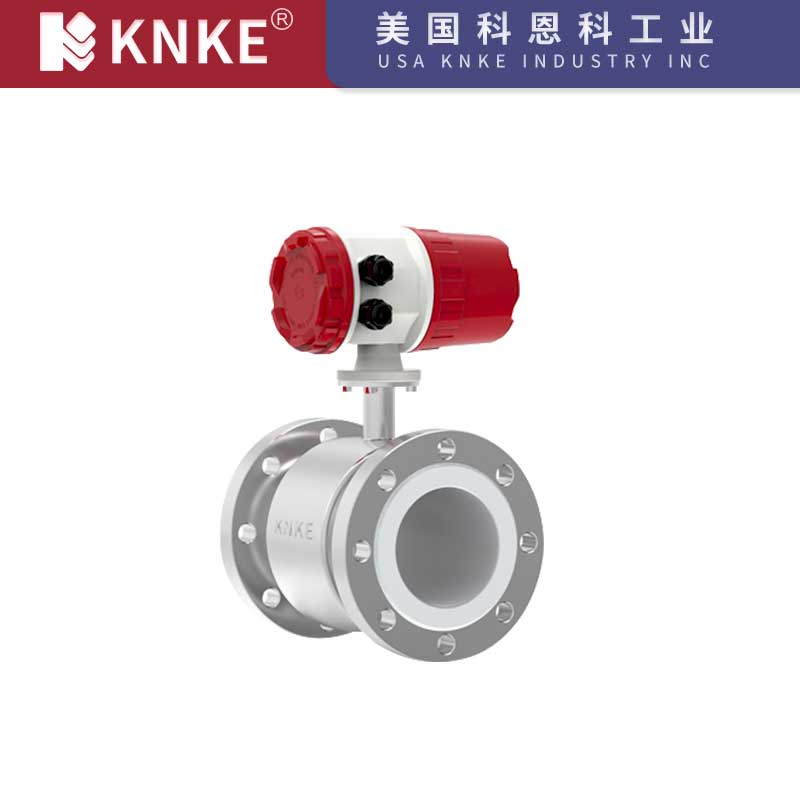Description
KNKE High-Precision Electromagnetic Flow Meter Overview
The KNKE High-Precision Electromagnetic Flow Meter, designed by KNKE USA, accurately measures the volumetric flow rate of conductive fluids. Featuring advanced microprocessor-based technology and digital excitation, this meter offers enhanced performance through its CAN field bus. With an accuracy of up to 0.2% and a measurement range of up to 1500:1, it is perfect for measuring flow in closed pipelines with conductive fluids.
Electrode and Grounding Ring Material Selection
Selecting the right electrode and grounding ring materials depends on the corrosiveness of the measured medium. For most fluids, choose materials based on the anti-corrosion manual. For more complex media, such as mixed acids, conduct a hanging test to confirm material durability. Generally, select electrodes with a corrosion resistance level one grade higher than the pipeline material. In cases with metallic pipelines lacking insulated coatings, you can match the grounding ring material to the electrode material or eliminate the grounding ring entirely.
KNKE High-Precision Electromagnetic Flow Meter Technical Parameters
| Parameter | Value |
| Nominal Diameter | Pipe-style: DN10–DN3000; Insertion-style: DN200–DN3000 |
| Flow Velocity Range | 0.1 to 15 m/s |
| Conductivity Range | ≥5 μS/cm |
| Current Output | 4–20mA DC, load resistance 0–750Ω |
| Digital Frequency Output | Output frequency adjustable from 1 to 5000Hz |
| Power Supply | AC220V, DC24V, or 3.6V battery |
| Straight Pipe Length Requirement | Upstream: ≥5DN, Downstream: ≥2DN |
| Explosion-proof Rating | ExmibdⅡBT4 |
| Protection Level | IP65, custom options for IP68 |
| Ambient Temperature | -25 to +60°C |
| Power Consumption | ≤20W |
Working Principle of the KNKE High-Precision Electromagnetic Flow Meter
The meter operates based on Faraday’s Law of Electromagnetic Induction. The measuring tube features a non-magnetic alloy and insulating lining. Electrodes are fixed along the pipe wall. The excitation coil generates a magnetic field perpendicular to the pipe axis. As the fluid flows, it cuts across the magnetic lines of force, generating an electromotive force (EMF) between the electrodes. The magnitude of the EMF correlates with the magnetic flux density, flow velocity, and pipe diameter. The transmitter processes the detected signal and outputs the flow rate data.
The output signal can convert into pulse, analog current, or other signals for further control and regulation.
Key Features of the KNKE High-Precision Electromagnetic Flow Meter
- Low-frequency Square Wave Excitation: This technology ensures stable zero-point operation, excellent anti-interference performance, and high reliability.
- No Flow-Obstructing Parts: With no moving components, the meter creates no pressure loss and is ideal for measuring slurries and viscous fluids.
- Corrosion-Resistant Materials: The meter’s electrodes and lining materials ensure long-term durability in harsh environments.
- Self-Diagnostics: Built-in self-diagnosis and error-checking functions with nonlinear correction for sensors.
- Flow Accumulation: Displays both forward and reverse accumulated flow with multiple accumulation counters.
- Easy Installation: The meter can be installed or removed quickly, making it ideal for retrofitting existing pipelines.
- Wide Flow Range: Features a high turndown ratio with minimal pressure loss.
- Power Loss Protection: Settings and accumulated data remain intact even after power interruptions.
Components of the KNKE High-Precision Electromagnetic Flow Meter
- Sensor: This includes the measuring tube, electrodes, excitation coil, core, and magnetic yoke.
- Transmitter: Amplifies and processes signals, displays flow data, and outputs control signals.
- Design Options: Available in both integrated and separate versions to meet different installation needs.
Applications of the KNKE High-Precision Electromagnetic Flow Meter
The KNKE High-Precision Electromagnetic Flow Meter finds widespread use in industries such as chemicals, metallurgy, environmental protection, pharmaceuticals, and paper manufacturing. It can accurately measure a variety of conductive fluids, including acids, alkalis, and salt solutions. Besides measuring flow, the meter also supports flow control and regulation.
Advantages of the KNKE High-Precision Electromagnetic Flow Meter
- Simple, Reliable Construction: With no moving parts, the flow meter boasts a long lifespan and minimal maintenance.
- No Pressure Loss: Its design prevents pressure drop by avoiding flow-obstructing parts.
- High Accuracy: The meter is unaffected by the fluid’s physical properties, such as temperature, density, and viscosity.
- Corrosion Resistance: Customizable electrode and lining materials make the meter adaptable to various fluids.
- Multiple Model Options: The meter is available in pipe-style and insertion-style configurations, catering to different installation requirements.
KNKE High-Precision Electromagnetic Flow Meter Performance Specifications
| Specification | Value |
| Accuracy | Pipe-style: 0.5% to 1.0%; Insertion-style: 2.5% |
| Flow Velocity Range | 0.2 to 8 m/s |
| Working Pressure | 1.6 MPa |
| Fluid Temperature | PTFE lining: ≤180°C; Rubber lining: ≤65°C |
| Explosion-proof | ExmibdⅡBT4 |
| Protection Level | Integrated: IP65; Separate sensor: IP68, Transmitter: IP65 |
| Output Signal | 4–20mA DC, load resistance 0–750Ω, supports RS485 or CAN bus communication |
| Power Supply | AC 90–220V, DC 24V ±10% |
| Maximum Power Consumption | ≤10VA |
KNKE High-Precision Electromagnetic Flow Meter Structure
- Sensor: Includes the measuring conduit, electrodes, excitation coils, and other components for fluid measurement.
- Transmitter: Processes signals and displays flow data, providing control signal outputs.
- Installation Methods: Available in integrated and separate versions to accommodate various installation requirements.
Classification by Excitation Method
- DC Excitation: Ideal for non-electrolyte fluids, such as liquid metals.
- AC Excitation: Commonly used in industrial applications but prone to electromagnetic interference. Low-frequency square wave excitation is gradually replacing this method.
- Low-frequency Square Wave Excitation: Offers better anti-interference performance and avoids the issues associated with traditional AC excitation.
Lining Material Selection
Choose lining materials based on the fluid’s corrosiveness and abrasiveness.
| Lining Material | Properties | Suitable for |
| Neoprene Rubber | Excellent wear resistance, flexible, resistant to mild acids, alkalis, and salts | Water, sewage, mud, and slurry |
| Polyurethane Rubber | Outstanding wear resistance but less effective against acids and alkalis | Neutral, high-wear slurries, coal slurry |
| PTFE (Teflon) | Excellent chemical stability, resistant to most corrosive substances | Strong acids, alkalis, solvents, sanitary fluids |
| F46 (PFA) | Superior strength, resistance to aging, and better tear resistance than PTFE | Hydrochloric acid, sulfuric acid, aqua regia, and strong oxidizing agents |
Electrode Material Selection
Electrode materials should be selected based on the fluid’s corrosiveness.
| Material | Suitable Medium |
| Stainless Steel | Clean water, sewage, and general liquids |
| Hastelloy | Highly corrosive media like strong acids and alkalis |
| Titanium | Corrosive fluids such as seawater, brine, and strong acids |
Maintenance and Calibration
Proper installation, calibration, and maintenance ensure longevity and accuracy.
- Regular Calibration: Calibrate the flow meter annually to maintain accuracy.
- Cleaning: Periodically clean the electrodes to avoid scaling or contamination.
- Power Supply Protection: Use a stabilized power supply to prevent voltage fluctuations.
- Check the Lining: Inspect the lining for wear, aging, or corrosion.

